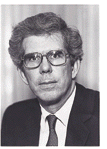Philip Don Estridge
| Don Estridge | |
|---|---|
 |
|
| Born |
June 23, 1937 Jacksonville, Florida |
| Died | August 2, 1985 (aged 48) Dallas/Fort Worth International Airport, Texas |
| Nationality | United States |
| Fields | Computer Science |
| Institutions | IBM |
| Alma mater | University of Florida |
| Known for | Developing the original IBM Personal Computer (PC) |
Philip Donald Estridge (June 23, 1937 – August 2, 1985), known as Don Estridge, led development of the original IBM Personal Computer (PC), and thus is known as "father of the IBM PC". His decisions dramatically changed the computer industry, resulting in a vast increase in the number of personal computers sold and bought, thus creating an entire industry of hardware manufacturers of IBM PCs.
Estridge was born in Jacksonville, Florida. His father was a professional photographer. He graduated from Bishop Kenny High School in 1955, and from the University of Florida in 1959. He married Mary Ann Hellier in September, 1958, and they had three children: Patricia Ann, Mary Evelyn and Sandra Marie.
He completed a bachelor's degree in electrical engineering at the University of Florida and worked at the Army, designing a radar system using computers, IBM and finally NASA's Goddard Space Flight Center until he moved to Boca Raton, Florida in 1969.
Before being the leader of the team to develop the IBM PC he had been the lead manager for the development of the IBM Series/1 mini-computer. After this project was unsuccessful, he was said to have fallen out of grace with IBM and was reassigned to headquarters staff – a position that IBM employees often considered a form of penalty.
His efforts to develop the IBM PC began when he took control of the IBM Entry Level Systems in 1980 (and was later named President of the newly formed IBM Entry Systems Division (ESD) in August 1983), with the goal of developing a low-cost personal computer to compete against increasingly popular offerings from the likes of Apple Computer, Commodore International, and other perceived IBM competitors. To create a cost-effective alternative to those companies products, Estridge realized that it would be necessary to rely on third-party hardware and software. This was a marked departure from previous IBM strategy, which centered on in-house vertical development of complicated mainframe systems and their requisite access terminals. Estridge also published the specifications of the IBM PC, allowing a booming third-party aftermarket hardware business to take advantage of the machine's expansion card slots.
...
Wikipedia
